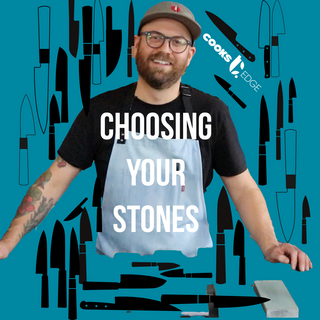Here at The Cook's Edge, a big part of what we do and what we are passionate about is knife sharpening. Each knife that comes into our shop is first assessed and then sharpened according to its needs. This could mean removing chips and rust from the blade, thinning the steel and sharpening on a variety of whetstones. While there is no one-size-fits-all for knife sharpening, we wanted to create a straightforward step-by-step guide to cover the basics. If you are interested in learning to sharpen your own knives using whetstones, please follow along on our blog over the next four weeks.
Learning to sharpen your own knives is a fun and useful skill to have. We don't recommend using a wheel or pull-through sharpeners as these can actually remove too much steel and damage your knives. You will get the best results if you sharpen your knives by hand using whetstones (also known as water stones).
Whetstones are categorized by their grit or coarseness. The lower the number of the grit, the larger the abrasive particles and the coarser the stone. As the grit number increases, the stones get less and less abrasive.
While there are countless options for stones, you really only need 3 to get started: a coarse, a medium and a fine.
- Coarse (between 200-600 grit)- You will need a coarse stone to remove the old, fatigued metal. You can also do some minor repairs with a coarse stone if there is any chipping of the blade.
- Medium (between 800-2000 grit)- A medium grit stone smooths out the bevel and further refines the edge.
- Fine (3000 grit and up)- This stone will smooth and polish the blade, making sure your knife retains its sharp cutting edge.
One thing to consider when choosing your stones is whether you are sharpening a Western knife or a Japanese knife. Japanese knives are made with much harder steel and can be polished with a higher grit stone for amazing edge retention.
While we inspect and treat each knife differently, here are some general examples of how we choose which stones to use here at The Cook's Edge:
- If not too dull, we like to start Japanese knives on 1000 grit if possible. We then move up to 3000, 5000 and possibly 8000 to finish.
- If a Japanese knife is really dull or needs minor repairs, we will start with a 220 or a 400 grit before moving up to the higher grit stones.
- If the knife is made of Japanese stainless steel (cobalt steel or VG10) we usually stop at a 5000 grit but if it is carbon steel we will finish with a higher grit of 6000-8000.
- For Western knives we often start with a 220 grit, progressing to a 1000 grit and then a 2000 grit stone.
- The 1000 grit stone is the workhorse of all our stones, almost every knife we sharpen will see this stone.
Additional Options for Stones:
Natural Stones- Unlike synthetic stones, natural stones are categorized by their hardness not their grit. While these are not used on Western knives, they are great for the sharpener who wants to unlock the full potential of their hand-forged Japanese knife.
Combination Stones- Like the name suggests, combination stones have a different grit on each side. They are a great option for the occasional sharpener who doesn't want to buy multiple stones or for someone who is travelling and can't bring their full range of stones with them.
*Knife Sharpening Tip* The whetstones that we sell and recommend should only be used with water, not oil. Some stones need to be soaked for 15-30 minutes prior to using while others just need a splash of water on top. A simple way to tell the difference is to wet the stone. If the water soaks in, it needs to be soaked and if the water just pools on top, it is a "splash and go" stone.
We hope this little guide will be helpful but as always we are available to answer any questions you may have about knife sharpening. Please contact us and we will be happy to help.
Next week we will be talking about a very important step when sharpening your knife- Raising a Burr! Stay tuned!


